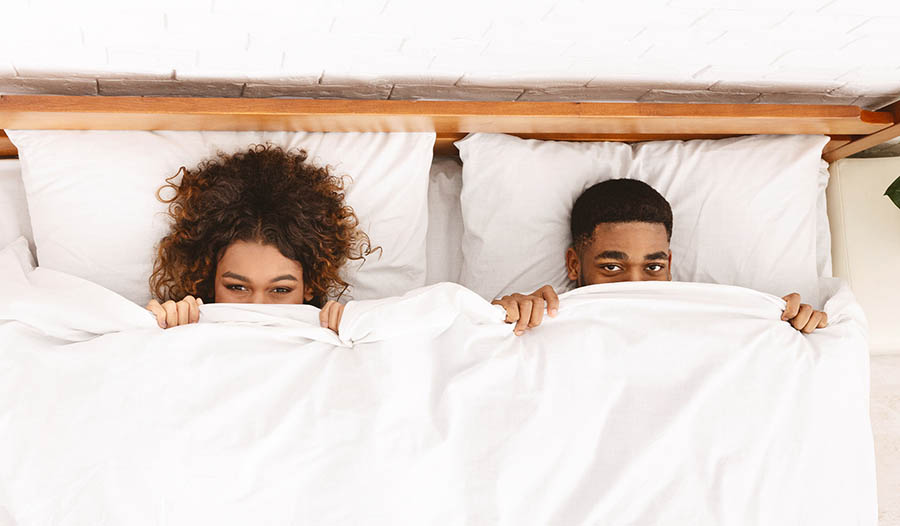The Circadian Rhythm and Insomnia
DISCLAIMER:This blog does not intend to provide diagnosis...
- In this article:
- A Bit about the Hypothalamus
- Melatonin and Circadian Rhythm
- Jetlag Disorder and Circadian Rhythm
- Shift Work Disorder and Circadian Rhythm
- Non-24-Hour Sleep-Wake Disorder and Circadian Rhythm
- Valerian Root and Sleep
- Chamomile and Sleep
- Maintaining Good Sleep Hygiene

The circadian system is essentially the biological clock of the body in charge of maintaining the daily rhythm of various bodily processes, such as body temperature, appetite, and sleep. A healthy circadian rhythm is what helps us feel awake during the day while allowing us to sleep deeply and peacefully at the night.
Circadian rhythm has been studied by countless researchers and professors for years, but Dr. Satchidananda Panda, of the Salk Institute in San Diego, California, is a leader in the field —he has conducted some of the most innovative and insightful research on the subject.
A Bit about the Hypothalamus
Dr. Panda’s research focuses on the genes and cells that serve as the building blocks of the circadian rhythm. His work is particularly focused on a portion of the brain known as the hypothalamus, which controls the circadian rhythm and utilizes several hormones to affect different parts of the body.
The specific part of the hypothalamus that is involved in the circadian rhythm is known as the suprachiasmatic nucleus, which regulates our internal clock when we are exposed to light and darkness. The brain receives information about our environment when light moves from the eyes and through the nerves that travel to deep inside the brain. After the information is received by the brain, a message is sent to another part of the brain that scientists call the pineal gland.
The pineal gland is also considered “the third eye”, and in Ayurvedic medicine, it is known as the third-eye chakra or Ajna chakra. The pineal gland is in charge of releasing the hormone melatonin, which is integral for sleep.
Melatonin and Circadian Rhythm
Melatonin is a natural “sleepy” hormone released by the pineal gland. It plays a large part in the circadian rhythm. Melatonin is secreted into the body during different cycles of the day and helps promote the AM/PM sleep-wake cycle that most of us are used to. The pineal gland makes and secretes more melatonin when it’s dark and decreases production when it’s light.
Although everyone creates melatonin, the amount secreted lessens as we age. Melatonin secretion starts in the first few months of our lives and increases until it plateaus throughout early adulthood. After that, melatonin secretion decreases in most people until it’s a fraction of what it once was — this could account for why some older people have more trouble falling asleep. It's also why melatonin supplements are often used to help treat insomnia, jet lag disorder, and shift- work disorder.
Suggested dose: 3-5 mg one to two hours before going to sleep.
Jetlag Disorder and Circadian Rhythm
Our internal clock is extremely dependent on our environment and how we interact with it. Jet lag disorder occurs when air travel puts us in different time zones in a short amount of time, which throws off the circadian rhythm because we don’t have enough time to adjust. Symptoms are usually worse on the first day after travel when our circadian rhythm will slowly start to try and correct itself. Taking melatonin supplements and timing exposure to light can help reduce the time needed to reset our clock
Symptoms of Jet Lag
- Daytime sleepiness
- Inability to sleep when desired
- Decreased alertness
- Decreased cognitive performance and memory issues
Shift Work Disorder and Circadian Rhythm
Our circadian rhythm is geared towards wakefulness in the day and sleepiness in the night. That's why work schedules that require staying up for long periods during the night and sleeping during the day can push our biological clock out of whack. People who work at night often experience an accumulation of “sleep debt” towards the end of their shifts as their circadian rhythm begins to promote sleep. The opposite happens during the day when circadian rhythm promotes alertness and prevents sleep. The best solution is to establish a sleep anchor, a specific time to sleep every day. Limiting exposure to light during preferred sleep times is crucial, and melatonin can also be used to help promote sleep.
Symptoms of Shift Work Disorder
- Decreased sleep quality
- Decreased sleep quantity
- Increased sleep debt
Non-24-Hour Sleep-Wake Disorder and Circadian Rhythm
Non-24-hour sleep-wake disorder results from a circadian rhythm that’s running for more than 24 hours at a time. It is most common in blind patients who are unable to receive stimuli and cues from light exposure, but it also occurs in some patients without vision problems. The main treatment for this is to train the circadian rhythm, which is primarily achieved through melatonin supplementation.
Symptoms of Non-24-Hour Sleep-Wake Rhythm Disorder
- Daytime sleepiness
- Intermittent insomnia
Beyond Melatonin
In addition to melatonin, there are other natural supplements that can be used in the treatment of insomnia, such as valerian root and chamomile, which work differently than melatonin and achieve sleep by affecting different processes in the body.
Valerian Root and Sleep
For hundreds of years, valerian root has been used in teas and other natural remedies to help decrease anxiety and promote sleep. It works as a sedative due to the action of the various compounds present in it, including alkaloids and flavonoids.
It also possesses GABA, a neurotransmitter in our brain that is in charge of slowing down and preventing messages between our nerves. The compounds present in valerian root can be used to stimulate the GABA receptors in our brain, ultimately resulting in sleepiness and sedation. Although valerian root is a nice alternative to some medications for treating insomnia, it has a few side effects and should be discussed with a doctor prior to use.
Side effects associated with valerian root:
- Drowsiness
- Dizziness
- Abdominal pain (when consumed in large doses)
Chamomile and Sleep
Chamomile is a natural herb that has been used for its anti-inflammatory, anti-anxiety, and sleep-inducing properties for thousands of years. Its sedative effects are due to compounds, such as flavonoid and apigenin, present in chamomile that bind to GABA receptors in the brain and help promote sleep. While chamomile is a generally safe and extremely common herbal supplement, its use should be discussed with a physician to make sure there aren’t any contraindications or potential medication interactions.
Side effects associated with chamomile
- Increases anticoagulant properties of other medications
- Dermatitis
- Anaphylaxis in those who are allergies
Other herbal supplements and teas that many find useful for aiding sleep include lemon balm, lavender, passionflower, and magnolia bark.
Maintaining Good Sleep Hygiene
Good sleep practices, also known as sleep hygiene, are a great deterrent for the development of insomnia. According to the National Sleep Foundation, good sleep hygiene includes:
- Avoid stimulants like nicotine and caffeine right before sleeping
- Stay away from food that could disrupt your sleep right before bed. This includes spicy foods, citrus fruits, fatty meals, and carbonated drinks — these are all things that could cause an upset stomach and disrupt sleep
- Establish a good sleep routine. This could include stretching, reading a book prior to sleep, or taking a shower before bed. A good sleep routine is something that will tell your body and brain that you are ready for sleep and help you slowly prepare for it.
- Limit naps during the day to 30 minutes. Naps are not good replacements for nighttime sleep, but they do help promote good mood and alertness when necessary. Just keep your naps on the short side in order to not disrupt nighttime sleepiness.
- Maintain a good sleep environment. Cell phone, computer, and television screen lights should be avoided as they can be a source of excessive ambient light, which can interfere with sleep and cause unwanted mental stimulation. If you do use them, consider blue-light-blocking eyewear. You can also check the display settings in your phone, as some devices have nighttime settings that filter out blue light.
- Create comfort. Pillows and bed mattress should be the right temperature and comfortable to help maintain good sleep.
- Promote good sleep through exercise. Participating in aerobic exercise, such as cycling or walking for up to 10 minutes prior to sleep, can have a great effect on nighttime sleep quality. However, excessive and strenuous exercise prior to sleep could have a negative effect on sleep, depending on the person.
The circadian rhythm is our internal biological clock that controls how we sleep and when we sleep. It originates from a part of the brain known as the hypothalamus, specifically in its suprachiasmatic nucleus. This part of the brain receives info from the eyes and sends signals to the pineal gland to control the release of the melatonin hormone. Accordingly, low levels of melatonin in the day help promote wakefulness while higher levels of melatonin at night promote sleep. Many circadian rhythm disorders or sleep disorders can be treated with exogenous melatonin or additional natural sleep remedies, such as valerian root and chamomile.
References:
- Bent S, Padula A, Moore D, Patterson M, Mehling W. Valerian for sleep: a systematic review and meta-analysis. Am J Med. 2006;119(12):1005–1012. doi:10.1016/j.amjmed.2006.02.026
- Bystritsky, A., Stein, M. and Hermann, R. (2019). Complementary and alternative treatments for anxiety symptoms and disorders: Herbs and medications. [online] Uptodate.com. Available at: https://www.uptodate.com/contents/complementary-and-alternative-treatments-for-anxiety-symptoms-and-disorders-herbs-and-medications?search=valerian&source=search_result&selectedTitle=1~13&usage_type=default&display_rank=1#H2255840 [Accessed 1 Apr. 2019].
- Damhoff TC, Huecker MR. Sleeplessness And Circadian Disorder. [Updated 2018 Nov 15]. In: StatPearls [Internet]. Treasure Island (FL): StatPearls Publishing; 2019 Jan-. Available from: https://www.ncbi.nlm.nih.gov/books/NBK534238/
- Dietary Supplements & Herbal Medications. In: Katzung BG, Kruidering-Hall M, Trevor AJ. eds. Katzung & Trevor's Pharmacology: Examination & Board Review, 12e New York, NY: McGraw-Hill;
- Electrical Activity of the Brain, Sleep–Wake States, & Circadian Rhythms. In: Barrett KE, Barman SM, Brooks HL, Yuan JJ. eds. Ganong's Review of Medical Physiology, 26e New York, NY: McGraw-Hill. http://accessmedicine.mhmedical.com/content.aspx?bookid=2525§ionid=204291821.
- Pack AI. Circadian Rhythms and Sleep Biology. In: Grippi MA, Elias JA, Fishman JA, Kotloff RM, Pack AI, Senior RM, Siegel MD. eds. Fishman's Pulmonary Diseases and Disorders, Fifth Edition New York, NY: McGraw-Hill; 2015. http://accessmedicine.mhmedical.com/content.aspx?bookid=1344§ionid=72261543
- Sleepfoundation.org. (2019). What is Sleep Hygiene? - National Sleep Foundation. [online] Available at: https://www.sleepfoundation.org/articles/sleep-hygiene [Accessed 1 Apr. 2019].
- Srivastava JK, Shankar E, Gupta S. Chamomile: A herbal medicine of the past with bright future. Mol Med Rep. 2010;3(6):895–901. doi:10.3892/mmr.2010.377
- Wyatt, J., Goldstein, C. and Eichler, A. (2019). Overview of circadian sleep-wake rhythm disorders. [online] Uptodate.com. Available at: https://www.uptodate.com/contents/overview-of-circadian-sleep-wake-rhythm-disorders?search=circadian%20rhythm&source=search_result&selectedTitle=1~111&usage_type=default&display_rank=1 [Accessed 1 Apr. 2019].
- Satchidananda Panda - Salk Institute for Biological Studies. (2019). Retrieved from https://www.salk.edu/scientist/satchidananda-panda/

 By Dr. Eric Madrid, M.D.
By Dr. Eric Madrid, M.D.


